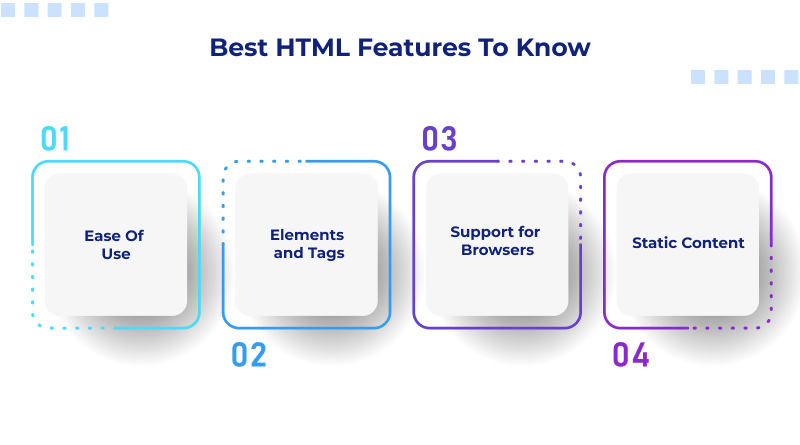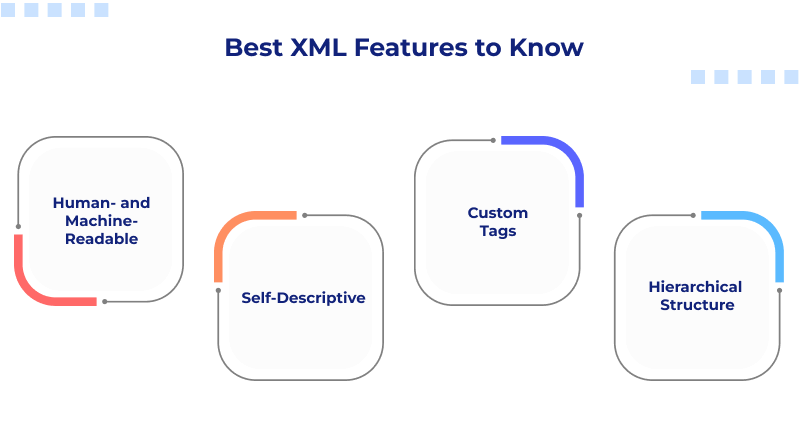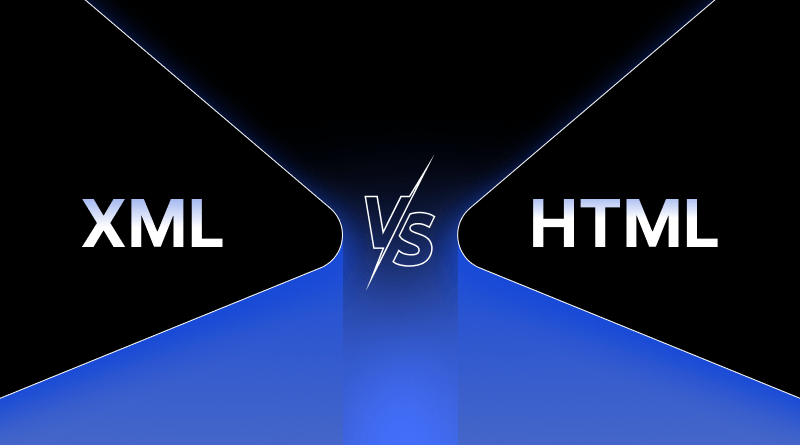Do you know that HTML is the structural backbone of the websites you visit? More than 90% of sites are built upon HTML for structure, a testament to its underpinnings of the web. Although XML may work less obtrusively on the frontend, it is a behemoth in the backend, making around trillions of data exchanges occur every day with its protocols. Knowing the differences between these two markup languages (HTML vs. XML) is valuable for enhanced work in the digital world.
Markup languages are methods for annotating a document so that the annotations are separated from the text. The markup languages are aimed at making information human- and computer-readable. Some common types of markup languages are HTML, XML, and Markdown. Each of this language plays a unique role in powering electronic communication, streamlining data processing, and in web development.
Table Of Content
What does HTML mean?
HTML stands for HyperText Markup Language. It is the standard markup language that outlines the steps to create and design an HTML webpage. HTML instructs a web browser about how to display text, images, videos, and other visual elements on a page. It encapsulates open and closing HTML tags and divides them into headings, paragraphs, lists, links, tables, forms, and more, employing predefined tags <a> and <div><div>.
Although HTML lacks the properties of a programming language, it works closely with CSS (the styling backbone of a webpage) and JavaScript (the element of change on the webpage) to bring life to the webpage’s structure and layout – the primary building blocks of any website. In brief, HTML enriches the website content by specifying content boundaries and, aided by other tools, creates the right place for content on the webpage. However, remember that HTML and HTML5 are different versions of the same language.
In short, HTML establishes the meaning and structure of web page content, delineating boundaries. Along with other tools and HTML hosting, it guarantees the content takes its proper location and form on the web page.
Best HTML Features To Know
HTML’s defining features include the very characteristics that mark its uniqueness as the building block of any website:

1. Ease Of Use
When comparing markup languages like HTML and XML, HTML stands out for its simplicity in both learning and implementation. The straightforward syntax of HTML helps structure a website within a framework. Even the newbies without any coding knowledge can make simple web pages with beautiful HTML fonts and a handful of tags, which is a big step toward web development.
2. Elements and Tags
HTML consists of tags and elements. In essence, tags act as directives that tell browsers how to interpret and display specific content. For instance, <h1> signifies a top-level heading, while <p> denotes a paragraph. Elements also have attributes that provide further explanation about their functionality.
3. Support for Browsers
All mainstream browsers, such as Chrome, Firefox, Safari, Edge, and others, work perfectly with HTML. This enables HTML written into documents to work without additional software across different systems and platforms.
4. Static Content
HTML is best used to deliver static content (it’s easy to create a simple website with no code). Information is considered static when it can only be changed by manually changing the code or integrating it with other technologies such as JavaScript or server-side scripting. HTML is effective for static content since it captures text, images, and layout structures.
What Is HTML Used For?
Let’s go over some of the practical uses of HTML:
1. Webpage Design and Arrangement
Every website needs HTML as its skeleton because it determines web pages using <header>, <nav>, <section>, <footer>, and other relevant tags.
2. Incorporating Multimedia Elements
Several multimedia elements can be added to HTML documents, such as video files, audio files, and images, among others. These elements enhance the overall browsing experience. Web developers use, among others, <video>, <audio> <, >, and/or tags to ensure web content compatibility across various devices and browsers.
3. Linking and Navigation
Hyperlinking is one of the most vital functions of HTML. Hyperlinks are made with the <a> tag, facilitating movement to different documents or websites externally or internally using web pages.
4. Forms Creation
Using HTML tags such as <form>, <input>, <textarea>, and <button>, data entry forms can be built. Gathering information such as usernames and passwords, feedback, and e-commerce checkout information is essential for users.
What does XML mean?
XML stands for the eXtensible Markup Language. It helps store, structure, or transport textual data, as it is a flexible, text-based code markup language. HTML is crafted to present data visually, whereas XML is structured to store and transport data in a format readable by both humans and machines.
Developers can define custom tags specific to applications or systems within XML. Such flexibility enables it to be useful in situations where standard tags, like the ones found in HTML, do not accurately capture more intricate or specialized information formats and structures that are particular to certain domains.
XML is critical for information storage and transfer between different software applications and frameworks. Its applications include configuration files, APIs, document formats such as Microsoft Office and SOAP, and many others. The strict hierarchy of XML structures ensures data integrity in regard to shareability, validation, and interpretation across disparate systems.
Best XML Features to Know
The distinguishable features of XML, in comparison with other markup languages, have to do with data organization along with communication across different platforms.

1. Human- and Machine-Readable
One of the most striking features of XML is its readability. The computer files that contain XML data are in text format, ensuring ease of reading for every developer. Such processing ensures the documents can be processed automatically while remaining open for scrutiny and manual adjustments, thus maintaining both forms of accessibility.
2. Self-Descriptive
The file’s content, along with its structure in XML, is described internally, meaning that the data tag is encapsulated in descriptive custom tags. For example,
<hostingPlan>
<provider>MilesWeb</provider>
<planName>Shared Hosting - Economy</planName>
<diskSpace>10 GB</diskSpace>
<bandwidth>Unlimited</bandwidth>
<features>
<feature>Free SSL Certificate</feature>
<feature>cPanel Control Panel</feature>
<feature>24/7 Support</feature>
</features>
<price>/month</price>
</hostingPlan>As you can see, the tags themselves (hostingPlan, provider, planName, diskSpace, bandwidth, features, feature, price) indicate the data they hold. This ability to describe themselves is a main feature of XML.
3. Custom Tags
Unlike HTML, which uses a standard list of tags, XML gives users the freedom to develop their custom tags depending on the needs of a particular application. This diversity allows for different types of data representation within systems across various fields and industries.
4. Hierarchical Structure
XML documents adhere to a tree or hierarchical structure where the elements can be nested within other elements. This is especially good for having complex and structured datasets as well as for precise data modeling.
What is XML Used For?
Here are some practical examples of what XML is used for:
1. Data Sharing Between Systems
Different systems use XML for sharing data, as it is easy for them to interoperate, built on different platforms or programming languages. For example, regional data processing centers found XML very useful in B2B applications and also for data feeds.
2. Settings Files
Numerous computer applications utilize configuration files in XML format. Top web applications such as the Apache and Tomcat web servers, as well as Eclipse-based development environments, use XML for controlling the system configuration, folder directory, and other parameters during the application execution.
3. Web APIs
XML is necessary for some of the oldest web services, including SOAP (Simple Object Access Protocol). The newer RESTful APIs, which prefer utilizing JSON, may still use XML for the structured and validated schema it offers.
Difference Between HTML and XML: The Central Subject
Understanding the comparison of HTML vs. XML requires noting that HTML and XML are popular markup languages, but their functions within the digital world differ greatly.
Information technology and web development as a whole require one to identify the differences between HTML and XML. While most web pages are built with an HTML backbone because it describes content display, XML is heavily used for data exchange, especially for different systems on different networks. Misunderstanding their purposes can lead to improper implementations or even inefficient website data processing.
The difference between HTML and XML goes beyond procedural differences; it is also ideological—HTML presents data while XML provides the means to handle and transmit the data.
Here is a side-by-side comparison of XML and HTML:
| Feature | HTML | XML |
| Full Form | HyperText Markup Language | eXtensible Markup Language |
| Purpose | Designed for displaying content on the web | Designed for storing and transporting data |
| Structure | Uses a predefined set of tags (e.g., <h1>, <p>) | Allows users to create custom tags |
| Flexibility | Less flexible due to predefined tags | Highly flexible; users can define their own tags |
| Error Handling | Tolerant; browsers can render pages even with minor errors | Strict; documents must be well-formed and valid |
| Case Sensitivity | Not case-sensitive; <Title> and <title> are treated the same | Case-sensitive; <Title> and <title> are different elements |
| Closing Tags | Some tags can be self-closing or optional | All tags must be properly closed |
| Whitespace Handling | Ignores extra whitespace | Preserves whitespace as part of the data |
| Data Presentation | Focuses on how data looks; used for web page layout | Focuses on what data is; used for data interchange |
| Use Cases | Creating and structuring web pages | Data storage, configuration files, APIs, and data interchange |
| File Extension | .html or .htm | .xml |
| Integration | Integrates with CSS and JavaScript for styling and interactivity | Often used with XSLT for data transformation |
| Parsing Requirements | Can be parsed by browsers without strict rules | Requires a parser that adheres to strict syntax rules |
| Development Tools | Visual Studio Code, Sublime Text, Notepad++ | Oxygen XML Editor, XML Notepad, Liquid Studio |
| Standardization Body | Maintained by WHATWG and W3C | Maintained by W3C |
| Nature | Static in nature | Dynamic in nature |
| Tag Definition | Tags are predefined and limited | Tags are user-defined and eXtensible |
| Data Handling | Does not carry data; only displays it | Carries data to and from databases and applications |
| Document Size | Generally smaller due to less verbose syntax | Can be larger due to verbose and descriptive tags |
| Parsing JavaScript | Does not require additional applications for parsing JavaScript | Requires DOM for parsing JavaScript and mapping text |
| Whitespace Preservation | Does not preserve whitespace | Preserves whitespace |
This difference in use case, syntax, and data management in HTML versus XML is well outlined in the above comparison. Distinction is important in choosing the right tool for the task of web development and software integration for developers.
Applications Of HTML And XML In The Real World
With one real-life example, the practical application of these languages is easier to comprehend. Following are more use cases accompanied with code that demonstrate the difference between XML and HTML.
Example Of An HTML Code Snippet
1. HTML To Create A Simple Web Page
<!DOCTYPE html>
<html>
<head>
<title>My First Web Page</title>
</head>
<body>
<h1>Welcome to My Website</h1>
<p>This is a paragraph of text on a basic web page.</p>
<a href="https://example.com">Visit Example</a>
</body>
</html>Through the use of this HTML structure, a heading, a paragraph, and a hyperlink are defined.\par Whenever a browser processes this structure, it presents the information for users to view.
Example Of An XML Code Snippet
1. MilesWeb Service Catalog Example:
<mileswebCatalog>
<hostingPlan>
<planName>Shared Hosting - Economy</planName>
<features>
<feature>10 GB Disk Space</feature>
<feature>Unlimited Bandwidth</feature>
<feature>Free SSL Certificate</feature>
</features>
<price>/month</price>
</hostingPlan>
<hostingPlan>
<planName>VPS Hosting - Plan 1</planName>
<features>
<feature>2 CPU Cores</feature>
<feature>2 GB RAM</feature>
<feature>50 GB SSD Storage</feature>
</features>
<price>/month</price>
</hostingPlan>
</mileswebCatalog>2. MilesWeb Resource Allocation Example:
<mileswebResources>
<server>
<location>Nashik, India</location>
<resource>CPU Cores</resource>
<allocated>8</allocated>
<available>16</available>
</server>
<server>
<location>Mumbai, India</location>
<resource>RAM (GB)</resource>
<allocated>32</allocated>
<available>64</available>
</server>
</mileswebResources>HTML and XML: How HTML and XML Complement Each Other
While the purpose of HTML and XML is completely different, there are numerous instances where the two are used simultaneously. It is essential for programmers to know how XML works within HTML so that they can develop more complex web applications.
– Employing XML within HTML
Editing XML files is quite common when HTML pages require nesting or linking structured components as part of the web development process. Although HTML cannot directly render XML the same way it does its tags, XML content can be rendered and retrieved using JavaScript with the help of AJAX.
Practical Examples of the Cooperation of XML and HTML
1. AJAX
One of the best-known XML in HTML example is AJAX. With this method, web pages can internally request information stored on the server (usually in XML) and subsequently use it to change a part of the page without reloading the page.
Example:
fetch('data.xml')
.then(response => response.text())
.then(data => {
// Parse and display XML data in HTML
console.log(data);
});2. RSS Feeds
RSS (Really Simple Syndication) feeds are written using XML markup and are often integrated into HTML websites or applications to provide real-time updates of content such as blogs, news articles, or podcasts.
For example, there are news websites that let users view their news articles in the form of an RSS feed. The website pulls out the XML data, such as the title and description of the news articles, and displays it using HTML.
3. XHTML (eXtensible HTML)
This is a mixture of HTML and XML. It observes certain requirements of XML, such as using well-formed tags and lowercase elements, but keeps the intention and outline of HTML. Pages written in XHTML are more uniform and therefore better suited for XML parsers.
HTML vs. XML: Which One Should You Use and When?
Deciding between XML and HTML depends on the type of project you are working on and its objectives. Here is a guide that might help you make the right choice:
- When to Use HTML:
- Purpose: Design the layout and the graphical interface of a web application or website.
- Examples: Landing pages, blogs, eCommerce websites, and content portals.
- Reason: HTML is browser-friendly and optimized for any HTML-enabled device. It works well with all web technologies; therefore, it is easier to integrate with CSS and JavaScript for animation, styling, and other interactive features.
- When to Use XML
- Purpose: Save, structure, and move data from one application/system to another.
- Examples: Configuration files, document formats, API responses (more so with legacy systems), and data feeds.
- Reason: XML can be used across different platforms, it is eXtensible, and it is best suitable for applications that need data validation and transport.
When to Use Both HTML and XML Together
- Objective: Build dynamic web pages that can either extract or send structured data.
- Examples: AJAX applications, embedded RSS feed widgets, and XHTML-compliant pages.
- Reason: While XML governs the structured data, HTML controls the presentation. As such, combining them both enhances an application’s functionality and interoperability.
XML and HTML are robust markup languages, but they are not meant for the same thing. XML (eXtensible Markup Language) focuses more on the structure, consistency, and logic of the information being presented as well as written data because its purpose is to store and transport. HTML (HyperText Markup Language), on the other hand, is what one uses when designing and creating pages and concentrates on how it will appear on the browser.
Every developer and data specialist needs to understand the differences between HTML and XML. While HTML provides elegant graphic interfaces, XML delivers structured data that is portable between different systems and platforms.
Creating modern applications requires both HTML and XML. HTML handles the presentation layer, while XML facilitates the backend, configuration files, and APIs. Professional mixing of both ensures a higher return in scalable and maintainable applications.
FAQs
1. What are the differences between HTML and XML?
HTML is a markup language that describes the structure of web pages and formats visual data. XML is used to define, store, and transport data, and it utilizes user-defined tags. HTML focuses on presentation, while XML is more about data management.
2. Is HTML a markup language?
Absolutely, HTML is a markup language: HyperText Markup Language. As the name suggests, it is used to mark up content with tags to structure documents on the World Wide Web so that they can be displayed with good formatting.
3. Is XML part of HTML?
Yes, great examples of XML being integrated into an HTML environment include RSS feeds and XHTML. Techniques such as AJAX allow the fetching of XML files for dynamic displaying, that demonstrates the common use of XML in HTML.
4. In what ways can XML be useful in everyday life?
Uses of XML include data storage, configuration files, web services like SOAP, document formats such as DOCX and SVG, and APIs. It is optimal for depicting structured data that requires validation or needs to be transferred.
5. Do HTML and XML qualify as programming languages?
No. HTML and XML are not programming languages. They are markup languages designed to mark up and organize content and data. There is no logic or control flow present in markup languages as there are in programming languages.















